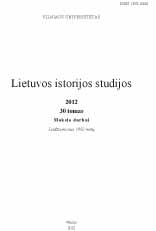BAJORŲ ŽEMVALDŽIŲ TAPATYBIŲ SLINKTYS XIX AMŽIAUS PABAIGOJE–XX AMŽIAUS PRADŽIOJE
Shifts of identities of the noblemen landlord’s in the late 19th – early 20th century
Author(s): Tamara BairašauskaitėSubject(s): History
Published by: Vilniaus Universiteto Leidykla
Summary/Abstract: The article analyses the shifts of identities manifested by the noblemen’s elite of the Western provinces in the late imperial Russia. Until the mid-19th century, the formal collective social identification of the nobles was more or less definite. Class dependency was defined by legal concepts (right of land and serf ownership, corporation right, mandatory registration in genealogical books, etc.). Those who belonged to the nobility were entitled privileges, whereas those who failed to hold to the upper classes found themselves in the lower strata of society. In the second half of the 19th century, the nobility faced the challenges of the modernising society and underwent social, economic, cultural and ethnic transformations. The turning point came after the abolition of serfdom. Land sustained its status as the key asset of society with most social groups struggling for its possession and the state leadership using it as an instrument of social and national policy. On December 10, 1865, a decree was passed, which provided against the purchase of estates by noblemen of Polish origin in nine Western governorates. Imperial bureaucrats responsible for the implementation of the decree faced the task of distinguishing the above-mentioned group from the other groups of society, i.e. identifying it. It was the social and national policy of the Empire rather than the modernization of society that forced landowners to reconsider their identity. The aim of the article is to examine what methods imperial bureaucrats employed in the identification of the elite among the nobility of the Western provinces and what resources and criteria the elite of the nobility used in the reformation of their collective identity. The research revealed that “bureaucratic nationalism” and the nobles themselves chose the same criteria for the definition of the elite’s identity, namely relation to land and nationality. The other attributes of identification (religion, language, and lifestyle) were of instrumental character and helped distinguish noblemen landlords from the small nobility, shlachta (former nobles, now townsmen and peasants) and other groups of society. In the late imperial Russia, the authorities seldom used the term “estate” for the identification of the noblemen’s elite, even when considering the possibility to reinstate the self-rule of the nobility and to allow military service in their homeland. The noblemen’s elite was equalized with the “class of landowners”, though the latter was represented not only by the nobility. Nobles of the Western provinces viewed class dependency as a cultural value with few benefits. They excluded the small nobility and shlachta from their collective identity. Imperial leadership used landownership as an instrument of political constraint. The noblemen’s elite considered land as a resource for their reformed identity.
Journal: Lietuvos istorijos studijos
- Issue Year: 2012
- Issue No: 30
- Page Range: 68-84
- Page Count: 17
- Language: Lithuanian

